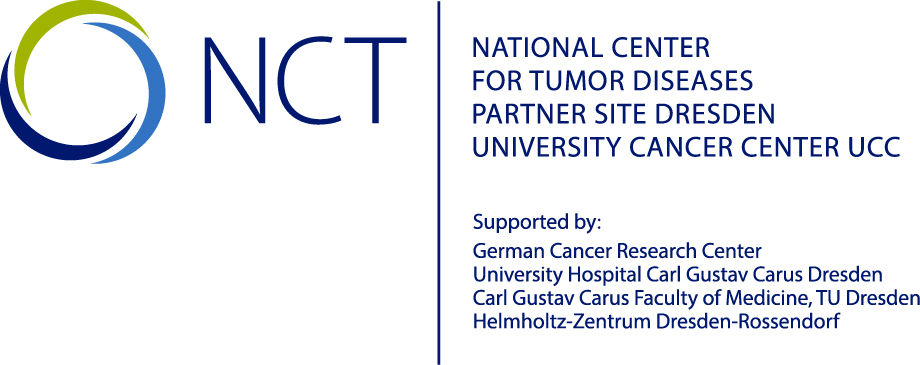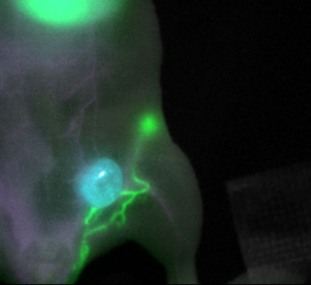Fluorescence imaging with short-wave infrared has the potential to increase the precision and safety of cancer surgery considerably. However, until now, there have been very few dyes that can be used in clinical settings. An international team of researchers led by scientists at the National Cancer Institute (Bethesda, Maryland, USA) and Helmholtz Zentrum München has now developed two new fluorescent dyes for short-wave infrared and a corresponding imaging system. For the first time, this opens up the possibility of making certain structures – such as the tumor, the surrounding healthy tissue and draining lymphatic vessels – visible simultaneously in a smooth video during surgery. Following his appointment to the National Center for Tumor Diseases Dresden (NCT/UCC), Professor Oliver Bruns will continue to develop this innovative imaging method for cancer surgery in Dresden. The results have been published in the prestigious Nature Methods journal (https://doi.org/10.1038/s41592-022-01394-6).
The National Center for Tumor Diseases Dresden (NCT/UCC) is a joint institution of the German Cancer Research Center (DKFZ), University Hospital Carl Gustav Carus Dresden, the Faculty of Medicine Carl Gustav Carus of TU Dresden and the Helmholtz-Zentrum Dresden-Rossendorf (HZDR).
Tumor surgery is a precision job. The aim is to remove the tumor and any metastases, while protecting healthy tissue and surrounding risk structures, such as nerves and vessels, as far as possible. It is hoped that, in future, fluorescence imaging using short-wave infrared (SWIR) with wavelengths greater than 1,000 nanometers will support surgeons in this difficult task. SWIR can produce much sharper images and provide insights into deeper tissue layers than is possible with conventional fluorescence imaging using infrared wavelengths between 700 and 900 nanometers. In addition, the innovative method offers the potential to light up selected tissues, vessels and body fluids simultaneously. Now that prices for suitable cameras have fallen considerably, thanks to rapid developments in industry, suitable dyes are the key bottleneck for medical application. “The advances achieved here in dye and technology development are now, for the first time, creating the necessary conditions for the visualization of various structures, such as tumors, draining lymphatic vessels and sentinel lymph nodes, in a process as dynamic as fluorescence-guided surgery,” says Professor Oliver Bruns, who was appointed Professor of Functional Imaging in Surgical Oncology at the National Center for Tumor Diseases Dresden (NCT/UCC) in February in a joint process involving TU Dresden and the German Cancer Research Center (DKFZ), and who is also a research group leader at Helmholtz Zentrum München. The results achieved in the field of fluorescence imaging during his time at Helmholtz Zentrum München form an important basis for future research in Dresden.
To develop the dyes, the researchers focused on cyanine dyes, which are some of the most frequently employed dyes in multicolor fluorescence microscopy. However, only a few of them are suitable for imaging in living organisms and in the SWIR range. Fluorescence dyes are generally administered intravenously and can sometimes be conjugated with antibodies that can be used to bind the dyes specifically to tumors. Through targeted computer-assisted further development of a clinically approved class of molecules, the researchers succeeded in developing two new dyes (FNIR-872 and FNIR-1072) that emit most of the light in the SWIR range following optical excitation. “Other key properties of the newly developed dyes are that they are non-toxic, highly water-soluble and can be conjugated with biomolecules that transport the dyes to the target structures in the organism,” explains Dr. Martin Schnermann of the National Cancer Institute.
Alongside their work on the dyes, the researchers also developed an imaging system with three lasers and an LED light source. This makes it possible to use indocyanine green (ICG), a dye that is already approved and which is suitable for SWIR imaging, at the same time as the two newly developed dyes, with their respective wavelengths. The different types of image information can be merged into one image and converted into a smooth video at a rate of eight frames per second. This opens up the possibility of giving surgeons a continuous view of all important target and risk structures during an operation. By contrast, conventional fluorescence imaging can only highlight individual structures, and the image quality is poor. The new imaging system also has the advantage of not being sensitive to visible light, so operations can be carried out under normal surgery theater lighting.
The new dyes and imaging system have already been successfully tested in preclinical experiments. In future, the aim is to further optimize the properties of the dyes so that they can, for instance, be produced more easily and conjugated more effectively with various biomolecules. “Our aim is for the new dyes and imaging system to be clinically available in a few years,” says Professor Bruns.
Publication:
Bandi, V.G., Luciano, M.P., Saccomano, M. et al. Targeted multicolor in vivo imaging over 1,000 nm enabled by nonamethine cyanines. Nat Methods (2022). https://doi.org/10.1038/s41592-022-01394-6
Fulltext: https://rdcu.be/cHVTz
A print-quality photo is available to accompany the press release:
https://www.nct-dresden.de/fileadmin/media/nct-dresden/das-nct/newsroom/pressemitteilungen/Fluoreszenz-Bildgebung1.png
CAPTION 1: Innovative fluorescence imaging reveals the tumor (blue), lymphatic vessels (green) and blood vessels (magenta). © Dr. Mara Saccomano, Helmholtz Munich
Media inquiries:
Dr. Anna Kraft
National Center for Tumor Diseases Dresden (NCT/UCC)
Press and Public Relations
Tel.: +49 351 458-5548
Email: anna.kraft@nct-dresden.de
www.nct-dresden.de
Dr. Sibylle Kohlstädt
Deutsches Krebsforschungszentrum (DKFZ)
Strategic Communication and Public Relations
Tel.: +49 6221 42-2854
Fax: +49 6221 42-2968
Email: s.kohlstaedt@dkfz.de
www.dkfz.de
Stephan Wiegand
Staff Unit Public Relations & Marketing
Carl Gustav Carus Faculty of Medicine at Technische Universität Dresden
Tel.: +49 351 458 19389
Fax: +49 351 458 885486
Email: stephan.wiegand@tu-dresden.de
www.tu-dresden.de/med
Holger Ostermeyer
Carl Gustav Carus University Hospital Dresden Press Office
Tel.: +49 351 458-4162
Fax: +49 351 449210505
Email: Pressestelle@uniklinikum-dresden.de www.uniklinikum-dresden.de
Simon Schmitt
Communications and Media Relations | Head and Press Officer
Helmholtz-Zentrum Dresden-Rossendorf
Email: s.schmitt@hzdr.de
Tel.: +49 351 260-3400
www.hzdr.de
National Center for Tumor Diseases Dresden (NCT/UCC)
The National Center for Tumor Diseases Dresden (NCT/UCC) is a joint institution of the German Cancer Research Center, the Carl Gustav Carus Faculty of Medicine at TU Dresden, the Carl Gustav Carus University Hospital Dresden and the Helmholtz-Zentrum Dresden-Rossendorf (HZDR).
The NCT has made it its duty to closely link research and patient care wherever possible. That is why cancer patients at the NCT sites can be treated based on the latest research results. At the same time, the proximity of laboratory and clinic provides researchers with important impulses for their practice-oriented research. The NCT sites share the common goal of developing the NCT into a top international center for patient-oriented cancer research. The Dresden center draws on the structures of the University Cancer Center Dresden (UCC), which was founded in 2003 as one of the first Comprehensive Cancer Centers (CCC) in Germany. Since 2007, the UCC has been honored by the German Cancer Aid e.V. (DKH) as a "Top Oncological Center" on a continuous basis.
German Cancer Research Center (Deutsches Krebsforschungszentrum, DKFZ)
The German Cancer Research Center (Deutsches Krebsforschungszentrum, DKFZ) with its more than 3,000 employees is the largest biomedical research institution in Germany. More than 1,300 scientists at the DKFZ investigate how cancer develops, identify cancer risk factors and search for new strategies to prevent people from developing cancer. They are developing new methods to diagnose tumors more precisely and treat cancer patients more successfully. The DKFZ's Cancer Information Service (KID) provides patients, interested citizens and experts with individual answers to all questions on cancer.
Jointly with partners from the university hospitals, the DKFZ operates the National Center for Tumor Diseases (NCT) in Heidelberg and Dresden, and the Hopp Children's Cancer Center KiTZ in Heidelberg. In the German Consortium for Translational Cancer Research (DKTK), one of the six German Centers for Health Research, the DKFZ maintains translational centers at seven university partner locations. NCT and DKTK sites combine excellent university medicine with the high-profile research of the DKFZ. They contribute to the endeavor of transferring promising approaches from cancer research to the clinic and thus improving the chances of cancer patients.
The DKFZ is 90 percent financed by the Federal Ministry of Education and Research and 10 percent by the state of Baden-Württemberg. The DKFZ is a member of the Helmholtz Association of German Research Centers.
University Hospital Carl Gustav Carus Dresden
The University Hospital Carl Gustav Carus Dresden offers medical care at the highest level of care. As a full-service hospital, it covers the entire spectrum of modern medicine. The University Hospital combines 20 clinics and outpatient departments, four institutes and ten interdisciplinary centers that collaborate closely with the clinical and theoretical institutes of the Faculty of Medicine.
With 1,295 beds and 160 places for day-care treatment, the Dresden University Hospital is the largest hospital in the city and also the only full-service hospital in eastern Saxony. Around 860 doctors cover the entire spectrum of modern medicine. 1,860 nurses and caregivers ensure the patients' well-being. The medical care of patients suffering from cancer, metabolic and neurodegenerative diseases is an important focus of treatment at the University Hospital.
Germany's largest hospital comparison by the news magazine "Focus" confirms that the University Hospital Carl Gustav Carus Dresden provides an excellent quality of treatment. That is why Dresden's university medicine comes second in the Germany-wide ranking.
Carl Gustav Carus Faculty of Medicine at Technische Universität Dresden
The Dresden University Medicine, consisting of the Carl Gustav Carus Faculty of Medicine and the university hospital of the same name, has specialized in research in the fields of oncology, metabolic as well as neurological and psychiatric diseases. Within these focal areas, the topics of degeneration and regeneration, imaging and technology development, immunology and inflammation, as well as prevention and health care research are of particular interest. International exchange is a prerequisite for top-level research - the Dresden University Medical Center embraces this concept with employees from 73 nations and numerous collaborations with researchers and teams from all over the world.
Helmholtz-Zentrum Dresden-Rossendorf (HZDR)
The Helmholtz-Zentrum Dresden-Rossendorf (HZDR) conducts research in the fields of energy, health and matter. It focuses on the following questions:
• How can energy and resources be used in an efficient, safe and sustainable way?
• How can cancer be better visualized, characterized and effectively treated?
• How do matter and materials react under the influence of strong fields and in smallest dimensions?
To answer these scientific questions, the HZDR operates large infrastructures that are also used by external measurement guests: Ion Beam Center, High Field Magnetic Laboratory Dresden and ELBE Center for High Power Radiation Sources.
The HZDR is a member of the Helmholtz Association, has five sites (Dresden, Freiberg, Grenoble, Leipzig, Schenefeld near Hamburg) and employs almost 1,200 people - about 500 of whom are researchers including 170 PhD students.







